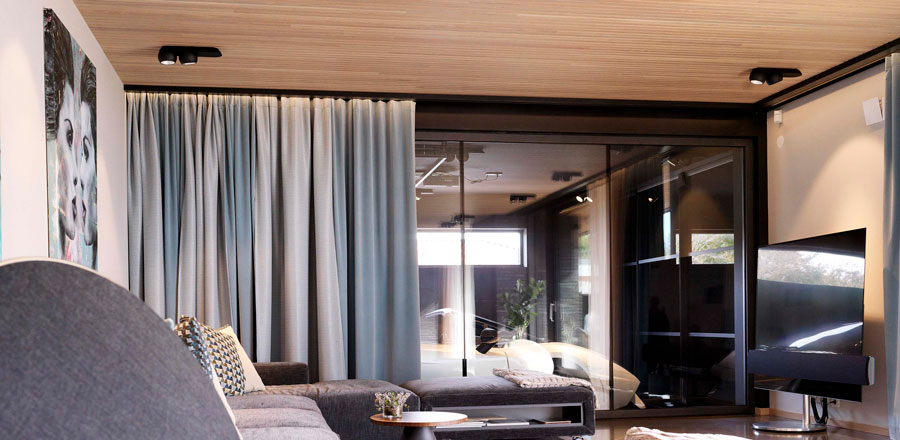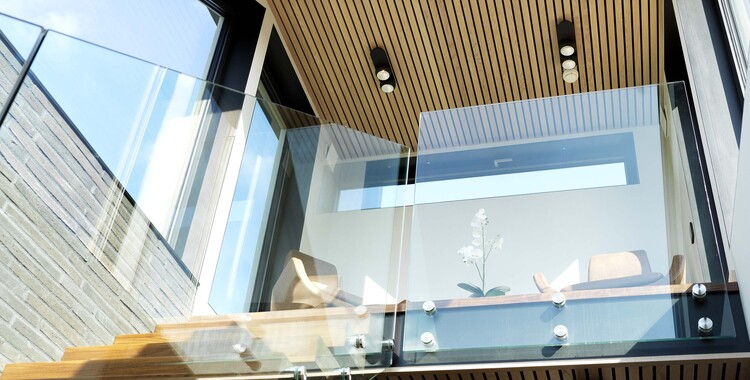WHEN THE GÖTESSON FAMILY WAS BUILDING A HOUSE on the Swedish west coast, acoustics were just as important as aesthetics. When the Götesson family found the plot for their house, there was a charming little summer cottage there. The idea was to demolish it as early as the following year. But they fell in love with the old cottage, and the demolition did not begin until five years after it was bought.
“We took our time and we were in absolutely no rush to create and sketch out our dream house,” says Johan Götesson.
In Frösakull in Halland County, a hundred metres from the beach and protected by mighty sand dunes, the family’s new home is now complete. We pay them a visit along with the architect Tomas Stringdahl.
“Tomas joined the project at an early stage, as we had worked together in product design at Gotessons, which was founded by my father. Agneta and I both like Tomas’s ideas and way of working, which are manifested in areas as diverse as office lamps and exclusive villas,” says Johan Götesson.
Many views of the seaside scenery
The plot is actually a flat extension of the beach, with a sparse beach forest to the north and the sea with its evening sun in the west. The challenge was to get the house to blend in without losing the qualities inherent in the site. The plot offered both opportunities and limitations. The maximum height of the house was 1.5 storeys, and the plot’s proximity to the sea, with its wind and salt spray, placed demands on the materials that could be used. The initial idea was a house built over one and a half storeys with a vaulted ceiling and a front that opened towards the sea.
“It was beautiful, but the flaws in the design quickly became clear. Who would want to live so close to the sea without a proper sea view? In a house hidden behind sand dunes several metres high?” asks Tomas.
This marked the start of an endeavour that shaped the entire construction process: working out the different lines of sight and views, both inside and outside the house. The family talks cheerfully about how strange they must have looked standing on various ladders on the plot to work out what the view would look like from different places and heights.
“We’re lucky none of our neighbours were at home to see us. We must have looked like burglars!” laughs Agneta.
Suggestion number two turned out to be just the right idea: a single-storey villa in a Spanish style with a gigantic roof terrace from which the family could take in the entire landscape and enjoy the view.
“We wanted the social areas, like the kitchen and living room, to be located centrally, and the bedrooms on the same level at either end of the house. No doorsteps, and a big wooden deck running the whole way along the side of the house,” say Agneta and Johan.
The project now entered a faster phase, and they set up a number of “rules” for what the house would feel like and what the experience of living in it would be. It was important for all the materials to withstand the tough climate, but also to fit in with the natural surroundings. Ground concrete floors are easy to maintain and create a comfortable surface, even for bare feet. Being made from sand, concrete provides a natural transition from the adjacent beach.

A calm atmosphere
Another important issue was the acoustics. Johan works in interior design, and particularly in acoustics, which was an important factor in the design.
“Single-storey open-plan houses are famously challenging. On top of that, here we had hard materials like the concrete floor and glass surfaces facing west along the entire length,” he says.
The solution was a ceiling made from white-pigmented oak which is used throughout the house, not just inside but outside too, giving an interlinking visual effect. The beams scatter the sound by means of diffusion. Residual sound waves pass between the wooden laths through a black acoustic screen before getting “stuck” in the sound absorbents right at the top, which cover the entire ceiling. A beautiful and highly effective acoustic solution. Colleagues from A. M. Acoustics were also involved in the project, and improved the solution still further. The family wanted to be able to sleep without disturbances, so the entire floor structure uses sound-insulating EcoSUND by A. M. Acoustics and high-density plaster. Overall, the reduction in sound transmission between rooms is dramatic.
“In theory we could have a party without our daughter even being able to hear it in her bedroom,” says Johan.
“Or, more likely, Nova can have all her friends over and play music without us hearing anything,” adds Agneta.
The big wooden deck was designed as a long, wide bridge along the sea-facing side of the facade. It can be accessed from every room through large glass sliding doors. Together with the matching guest cottage, the house creates the effect of an enclosed courtyard warmed by the sun on windy days. The house’s projecting roof also means it feels like the wooden deck is actually inside, and even on rainy days there is no need to close the sliding doors.
Remarkable details
The house also includes a number of unexpected and spectacular design solutions. At the entrance, you can see the wide entrance door, which can be opened easily thanks to the placement of the hinge, which is further in than usual by an additional third. It works like a pivot window on its side. Once in the entrance hall, Arne Jacobsen’s classic egg armchair can be seen on the left, beside a work of art by Emil Olsson painted right onto the wall by the artist himself. Inside the living room, which is separated off by a concrete step which gives a mini-mezzanine effect, is what may be the house’s most unusual detail. The entire short side consists of a pane of glass looking into the garage that houses the family’s recreational vehicle: a Lamborghini Gallardo LP 570.
“During the design process, it became clear that Johan is strongly influenced by his work with customers in the experience industry. There needed to be a bit of showbiz, and that was a lot of fun for me as an architect,” says Tomas.
The house’s Spanish style is crowned by the roof terrace, covering a full hundred square metres, accessed via a staircase in the short side of the house. At the opening to the terrace is a small lookout corner, protected on all sides by glass and ideal for sitting in during the colder months. Because the family is very sociable, the roof terrace fits their lifestyle well with the beach as a beautiful backdrop. To the south is the island of Tylön, and to the west and north are the beaches at Frösakull. The roof includes sitting areas and even a spa bath, all with the same amazing view.
Now that the house is finished, what are the plans for the grand opening?
“We’ve already had a few parties, but nothing really big,” say Agneta and Johan with a smile.

Villa Götesson
With modern style and fantastic acoustics on the west coast
Take a closer look and find inspiration.






